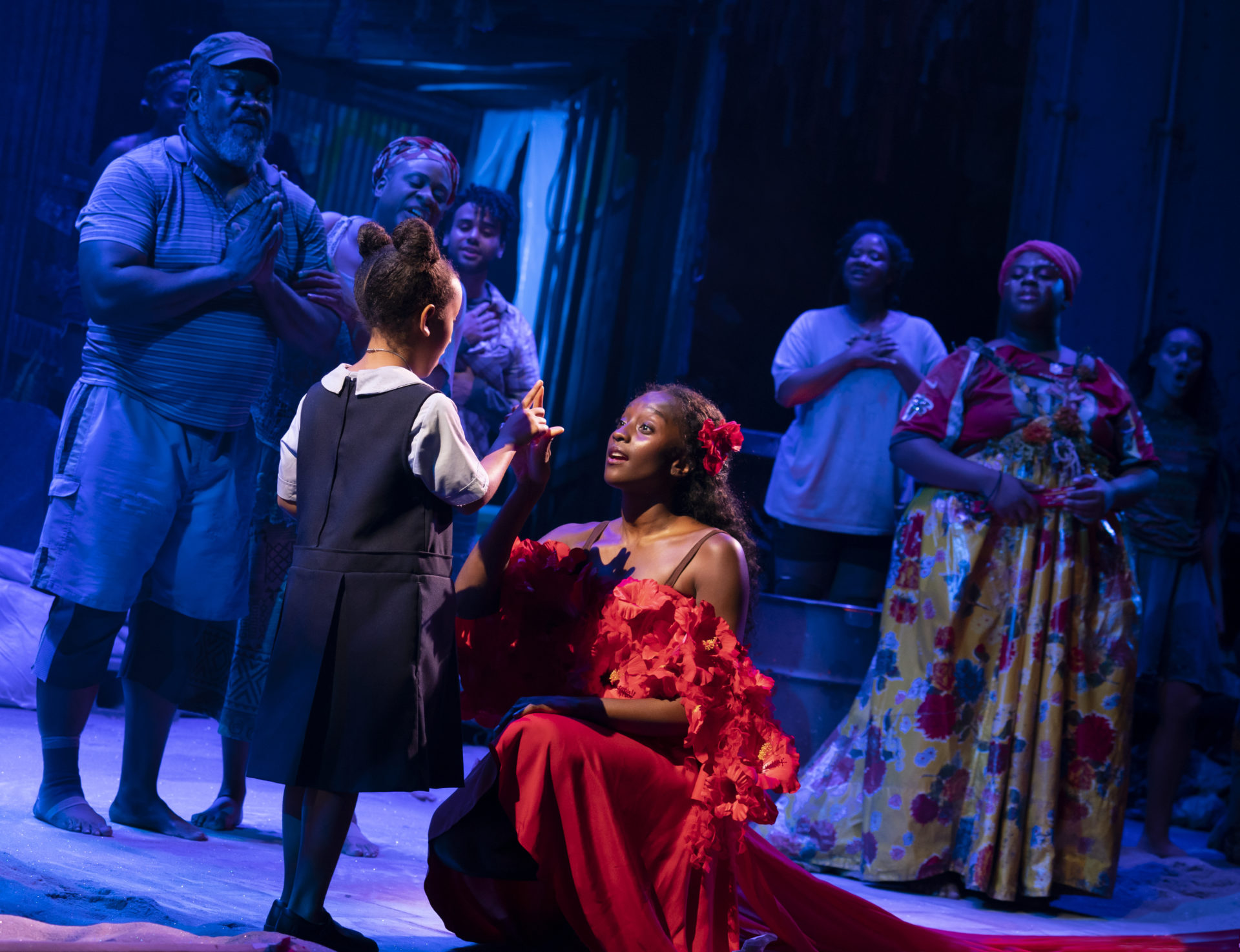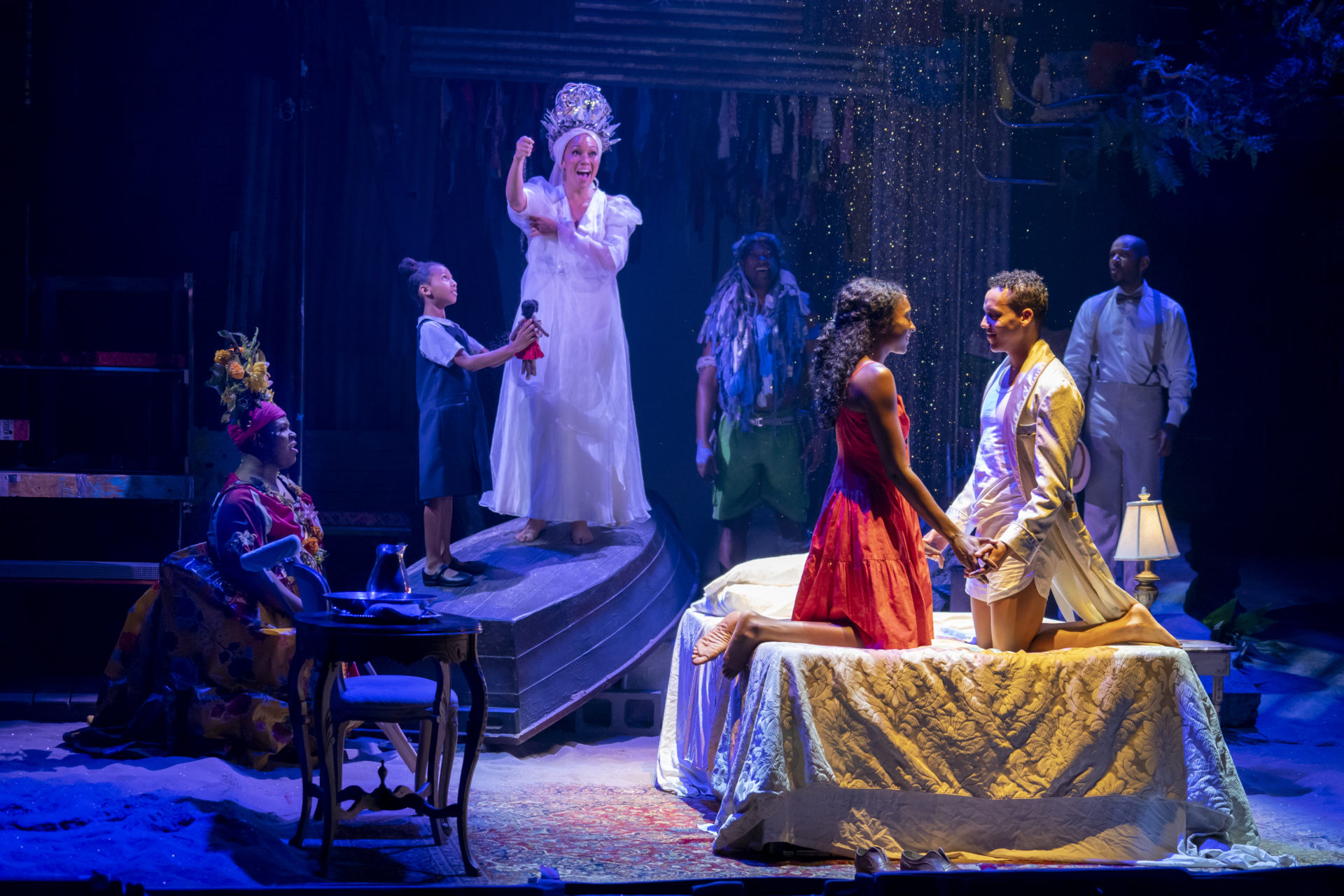At TPAC
‘Once on this Island’ Opens its U.S. Tour in Nashville
A bustling stage and charged audience await the opening night of the National Broadway Tour for Once on This Island. Originally designed and performed “in the round”, the show accommodates that same intimacy by seating audience members within Dane Laffrey’s elaborate set design. The primary staging area is front and center, and there are several inlets on either side, as well as two elevated platforms that house the musicians. Though crude and colorful, the set easily morphs to whatever environment is required- for the beginning, the setting is a contemporary dwelling on an island in the French Antilles. Corrugated metal panels and stained fabrics adorn the different levels of the set pieces. Audience members are led onto the stage to take their places in the ambience as the cast members interact with one another. After an amusing bit featuring the phone of an “audience member” meant to deter the use of electronic devices during the show, the lights dim and the players begin.
Rosa Guy’s novel My Love, My Love: Or, the Peasant Girl, the source material from which this show was adapted, tells the story of a young girl named Ti Moune who falls in love with a man of a higher class than she as she nurses him back to health from an accident. Though the characters and circumstances differ from the novel to the musical, the general sentiment remains the same. Once on This Island features a beautiful and spirited young woman, seemingly protected by the Gods, who feels she is destined for a story larger than the one of her home. In a world rife with natural disaster and tragedy, director Michael Arden finds it important to

point out that “no place or person is immune to the power and wrath of the gods.” Thus, our heroine’s lovelorn end is both bittersweet and jubilant, celebrating the cyclic nature of life and the power of one ray of hope to survive even in the greatest darkness.
Courtnee Carter portrays Ti Moune with such earthen grace and enthusiasm, not to mention her powerful vocal range and ability. Even in her exposition, the agility of her voice in transferring from a belting chest voice to a tender and fragile timbre is striking. Ti Moune is both headstrong and devoted, and Carter navigates her character expertly in the way she sings and moves. MiMi Crossland melts hearts as Ti Moune’s younger self and real-life counterpart with a voice that soars confidently through the din of adult voices. Her on-stage quick change from the school-child uniform to the signature red dress of Ti Moune is exquisitely executed with the help of fantastic lighting and an ever-moving ensemble. No member of the cast is less than superb. Jahmaul Bakare, Kyle Ramar Freeman, Tamyra Gray, and Cassondra James shine as both storytellers and Gods: Bakare’s Agwe is mighty, Gray’s Pape Ge maliciously enthralling, and James’ Erzulie elegant and nurturing. Freeman captivates as Asaka, with demonstrative vocals that are nothing short of impressive. Philip Boykin’s deep and hearty voice warms the Tonton Julian, a complement to the caring and maternal Danielle Lee Greaves (Mama Euralie), and it proves difficult to not fall for Tyler Hardwick’s Daniel right along with Ti Moune. The ensemble bewitches as they seamlessly weave between being storytellers to set pieces to supporting roles.
Despite an incredible overall performance level, several moments of the show stand out in terms of general effect. The marriage of lighting and staging come together so harmoniously in the initial storm that one could forget the reality of being surrounded by four walls and a ceiling in a theater. Similarly, the car ride and consecutive car crash are electrifying to behold. When the ensemble forms the simulated car and Hardwick mimes the effect of a bumpy road, the cast members make believing the pantomime easy for the audience with skillful delivery and precise timing. The crash itself is jarring as Daniel is ejected from the vehicle amidst the thunder and rain. Another moment of note is the tale of the Beauxhommes via the shadow show behind the storytellers. The ability to emote and communicate through posture and movement alone is remarkable, and each cast member involved performs exceptionally.

Finally, possibly serving as the most important moment of the show is Ti Moune’s dance at the ball. Not only rich in color and imagery, the scene is solidified by the entrancing choreography that serves specifically to each character that joins the dance. Ti Moune’s radiance sparks inspiration in one dancer at a time, breaking barriers of class and skin color until finally reaching the puzzling Daniel. It is a moment full of love and irony, but this moment unfortunately also serves as the first whiff of Ti Moune’s heartbreaking downfall. By this point in the show, the costuming has transformed several times, from contemporary fashion to embellished civilian costuming of the Gods, and then to formal attire of centuries past. Integral and integrated, the costumes are indicative of each character’s attributes from one setting to another.
Unity is the primary theme of the musical, both in production and message. On the surface level, the plot revolves around the story of a young girl attempting to unite two different groups of people. However, beneath the surface, the plot also stresses the integration of the spiritual world with terrestrial events. Cassondra James’ flute interlude is an excellent example of this theme, as she, the God Erzulie, responds to the vocalists within the instrumental accompaniment of “Ti Moune.” Though subtle, this gesture is powerful in reinforcing the role of the Gods in Ti Moune’s journey. Even beyond this moment, the instrumentalists’ execution of Stephen Flaherty’s score is both supportive and evocative, with the use of unconventional sounds to represent the supernatural and a variety of musical styles intensifying the idea of a story weaving throughout time.
…an absolute masterclass in integration, with flawless storytelling enhanced by brilliant costuming and lighting.
Once on This Island is an absolute masterclass in integration, with flawless storytelling enhanced by brilliant costuming and lighting. Exhibiting an excellent cast and wonderful staging, the one act passes in a flash, reiterating the idea that stories and culture go hand in hand, and that the story being told is not only timeless, but perhaps even more important- timely.
This production of Once on This Island will continue in Nashville through October 20th. Tickets are available at TPAC.org For more information, visit onceonthisisland.com, or find the show on Instagram, Twitter and Facebook.



